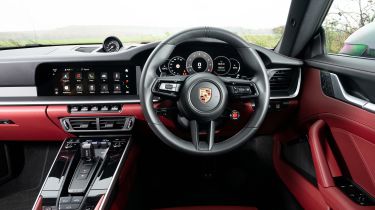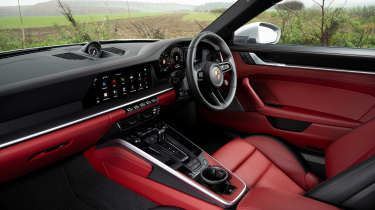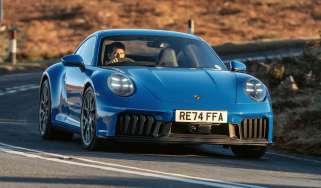Porsche 911 review - Interior & comfort
The Porsche 911’s interior is a great place to spend time; overall quality and slick infotainment are particular highlights
A welcome evolution of the outgoing 991-generation 911’s already impressive interior, the 992’s is more refined in its design and boasts a great set of technological improvements. All of the materials used are high-quality and everything is solidly put together.
Porsche’s reputation for great seats is maintained, with a great driving position and optimal comfort; optional sports seats offer extra support during enthusiastic driving.
The 911’s suspension is well set up to offer a great balance between poise and comfort – especially when Porsche’s PASM adaptive dampers are chosen from the options list. The depth of the Porsche’s options list means that buyers can build their 911 to suit everything from everyday motorway use to weekend track-day action – or a balance between the two.
The Porsche 911’s interior is more than fitting for its hefty price tag – you won’t feel short-changed, especially once it’s crafted to your exact specifications.
Porsche 911 dashboard
The 911’s dashboard is simple in its design but offers great access to Porsche’s latest infotainment system, which displays information via and a centrally mounted 10.9-inch touchscreen. For the 992.2 update in 2024, the analogue rev gauge was ditched in favour of a fully-digital 12.6-inch curved display, which is a bit of a shame but remedies some of the quirks of the old partly-digital setup.
More reviews
The touchscreen controls just about every aspect of the car, though physical climate control switches are located just ahead of the gear selector. Physical shortcut toggles under the central screen help locate important functions easier on the move. A multifunction steering wheel is standard, with buttons for controlling the sound system, Bluetooth and other infotainment functions. Apple CarPlay is now more deeply integrated, too, with the ability to display information in the instrument cluster and for Apple’s Siri voice assistant to directly control vehicle functions.
There are several different leather colours to choose from, available in a dizzying array of combinations. These are complemented by a choice of brushed metal, wood and carbon fibre finishes; whatever the customer’s taste, the end result is guaranteed to be of high quality.
Equipment
The Porsche 911 range is broad but relatively simple: with the 992 generation including Carrera, Carrera 4, Carrera T, Carrera S, Carrera 4S, GTS, Turbo and Turbo S derivatives, available in coupe, Targa or Cabriolet convertible body styles, with the flagship GT3 only available in coupe form.
While the 2024 992.2 changes were fairly subtle, they do add up. For a start, the car is now more aerodynamic thanks to bodywork changes and active cooling air flaps adorning its nose, which help to direct air flow as required, then close to reduce drag for improved efficiency. Its headlights have been upgraded to the latest matrix LED technology, while OLED tail-lights feature at the rear of the car.
The 911 992.1 Carrera, Carrera 4, Carrera T, Carrera S, 4S, GTS, Turbo and GT3 models get 20/21-inch alloy wheels (the rear wheels are bigger), a tyre pressure monitoring system, start-stop, two small rear seats and Porsche Communication Management (PCM), which brings phone connectivity, a voice control system and an Internet-connected sat nav system. The aforementioned infotainment screens are standard, as is DAB radio and an eight-speaker, 150-watt sound system.
In the pre-facelift 992.1, LED headlights and tail-lights were standard, with automatic activation and welcome-home lighting. The door mirrors are heated and electrically adjustable. Keyless-go, parking sensors front and rear, cruise control with a speed limiter, and two-zone climate control are all standard-fit too.
Black leather upholstery is standard, as are heated front sports seats and a multi-function steering wheel, while the T and GTS models have leather seats featuring Sport-Tex suede inserts. The Dakar doesn’t get lots of changes as standard, but a centre top marking on the steering wheel is a nice nod to its rally heritage, along with figure-hugging seats that are excellent while cresting a sand dune, but a bit firm on a long motorway trip.
Options
The options list for the Porsche 911 is long, varied and expensive but few other production sports cars offer as much scope for personalisation.
Aside from the standard alloy wheels, there are additional designs to choose from, several different interior leather combinations (and a range of extra touches available, including two-tone and ‘Club’ leather upgrades). The standard stereo can be replaced with either a 12-speaker Bose system or a 915-watt, 13-speaker Burmester system. All of these options can range from just a few hundred pounds into the thousands, all depending on how bespoke you want your car to be.
The 911’s headlights can be upgraded to adaptive HD-Matrix LED items for just over £2,500, while privacy glass costs around £500 and even the addition of a rear windscreen wiper is £300. We’d recommend the sonorous sport exhaust, but it’s a shame Porsche still charges £1,500 for adaptive cruise control and over £700 for lane-change assist – features that are standard on many mainstream vehicles. A Burmester high-end stereo is a cool £4,000.
Which Is Best?
Cheapest
- Name2dr PDK [4 Seat]
- Gearbox typeSemi-auto
- RRP£106,695
Most Economical
- NameGTS t-Hybrid 2dr PDK
- Gearbox typeSemi-auto
- RRP£140,875
Fastest
- NameGTS t-Hybrid 2dr PDK
- Gearbox typeSemi-auto
- RRP£140,875














